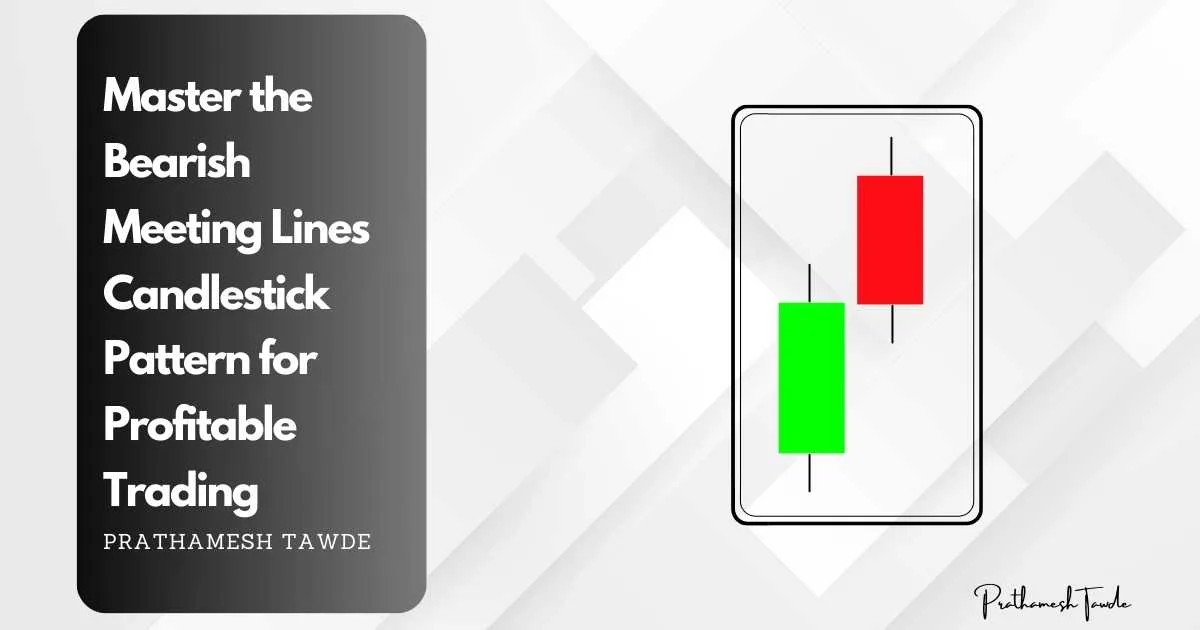Bearish Harami :- 3 Easy Ways to Trade the Pattern
- Prathamesh Tawde
- December 16, 2023
Understanding Bearish Harami Candlestick Pattern
Trading is dynamic. People make decisions in split seconds and markets change rapidly. So, knowing technical analysis is crucial. One crucial part of technical analysis is recognizing candlestick patterns. They give valuable insights into market sentiment. Of these patterns, the bearish harami is key for traders. It helps them find potential reversals in price trends.

Introduction
The bearish harami is a two-candlestick pattern. It signals a potential reversal from an uptrend to a downtrend. It is a large bullish candle followed by a smaller bearish candle. The bearish candle is fully inside the body of the previous candle. This pattern suggests market indecision. The bullish momentum is fading and a bearish reversal may happen.
Identifying pattern
To recognize a bearish harami pattern, traders look for two key components:
A large bullish candle on the first day, indicating upward momentum.
The second day has a smaller bearish candle. It is completely inside the body of the previous candle.
Psychology Behind bearish harami pattern
The bearish harami pattern reflects a shift in sentiment from bullish to bearish. The first day’s bullish candle shows buyers are dominant. But, the smaller second candle suggests a loss of momentum. This change in sentiment often results from profit-taking or market indecision.
Significance Trading
For traders, spotting a bearish harami pattern can be a signal. It can signal them to consider exiting long positions or even opening short ones. But, you must confirm the pattern with other indicators or price action. This will increase the signal’s reliability.
Recognizing Bearish Harami in Charts
Let’s look at a real example of a harami pattern. In Company X’s stock chart, we see a bullish trend. A bearish harami pattern follows it. After that, the stock price goes down instead of up. It starts a downtrend, proving the pattern’s importance in predicting price reversals.

Trading Strategies
Traders often use various strategies when trading bearish harami patterns. Some common approaches include waiting for confirmation signals. You can also set stop-loss orders. And, consider the overall market context before making trading decisions.
1. Confirmation with Technical Indicators
One way to trade the bearish harami is by using technical indicators to confirm the pattern. Tools like the RSI and MACD can help confirm the bearish harami’s potential reversal. When these indicators diverge from the price, they signal a bearish move.
2. Implementing a Stop-loss Strategy
To manage risk well, consider using a stop-loss strategy. Use it when trading the bearish harami pattern. Setting a stop-loss level can help limit losses. It does so if the market reverses. This approach helps maintain discipline and protects your capital in volatile conditions.
3. Combining with Price Patterns
For added confirmation, consider combining the bearish harami pattern with other price patterns. Look for confluence with patterns. For example, bearish engulfing or evening star formations. They will bolster your confidence in entering short positions. You can improve your trades by combining technical indicators and price patterns. Doing this makes your trades more accurate.
Common Mistakes to Avoid
When trading bearish harami patterns, avoid common pitfalls. They may undermine trading strategies. One mistake is overlooking confirmation signals. Relying only on the harami pattern without confirmation can lead to false signals.
Also, ignoring market context and fundamentals may lead to misinterpreting candlestick patterns. Traders should consider external factors. These include economic indicators, news events, and market sentiment. They should consider these factors when analyzing patterns.
Bearish Harami vs Bullish Harami
Bearish Harami:
First Candle: Large, bullish (green).
Second Candle: Smaller, bearish (red), within the range of the first candle.
Implication: It suggests that the uptrend is losing steam.
It’s often used to find potential short-selling opportunities. They come at the end of a bullish trend.
Traders might look for confirmation. They want to see a break below the low of the second candle before entering a short position.
First Candle: Large, bearish (red).
Second Candle: Smaller, bullish (green), within the range of the first candle.
Implication: It’s indicating the downtrend is weakening.
Utilized to spot buying opportunities at the end of a bearish trend.
Traders might wait for a break above the high of the second candle before entering a long position.

Key Differences:
- Market Direction: The two patterns differ in what they imply for market direction. A bearish harami shows a potential uptrend reversal to a downtrend. A bullish harami shows a potential downtrend reversal to an uptrend.
Candlestick Structure: While both patterns consist of two candlesticks, their structure is opposite. In a bearish harami, the first candle is bullish and the second is bearish. In a bullish harami, the first candle is bearish and the second is bullish.
Context: Traders must consider the context in which these patterns appear. A bearish harami is more important when it follows a long up-trend. A bullish harami is more important when it follows a long down-trend.
In short, bearish and bullish harami patterns look similar. But, they imply opposite market directions. Traders use these patterns in technical analysis. They use them to find potential reversals and make smart trades.
Conclusion
In conclusion, the bearish harami candlestick pattern is a valuable tool for traders. It helps them to find potential reversals in price trends. Traders can use this pattern’s power. They do this by understanding its traits. They read market sentiment and use fitting strategies. These steps will improve their decisions and trading results.
A bearish harami is a two-candlestick pattern. It shows a potential shift from an uptrend to a downtrend. It consists of a big bullish candle. A smaller bearish candle follows it. The smaller one is completely engulfed within the body of the big one.
Traders use patterns as signals. They consider exiting long positions or starting short ones. However, you must confirm the pattern with other indicators or price action. We need this for better reliability.
People rely only on the pattern. They do so without considering other factors. These factors include volume, trendlines, and support/resistance levels. Traders should avoid using this pattern to make decisions. They should check signals well.
Yes, patterns can occur in many financial markets. These include stocks, forex, commodities, and cryptocurrencies. The pattern’s significance remains consistent across different markets.
Yes, traders can manage risk. They can use techniques. For example, they can set stop-loss orders. They can also diversify their portfolios and size positions right. These techniques help them manage risks from trading patterns.

I’m Prathamesh Tawde, a leading figure in the dynamic world of financial markets. Born on March 30, 1986, in the vibrant city of Thane, Maharashtra, I’ve nurtured a profound passion for technical analysis and a commitment to guiding individuals toward successful trading journeys. With a mission to empower and educate, I’ve carved a distinct niche as a content creator, educator, and mentor.





